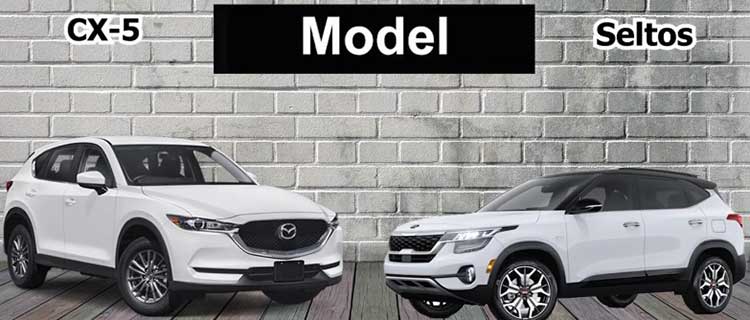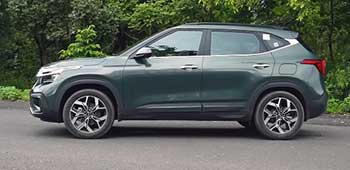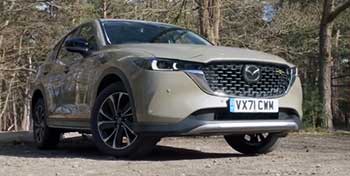I’ve always been fascinated by the compact SUV market, and when it came time to pick a new ride, I found myself torn between the 2025 Kia Seltos and the 2025 Mazda CX-5. Both vehicles promise practicality, style, and performance, but which one truly delivers? In this article, I’ll share my first-hand analysis, breaking down the pros and cons of each to help you decide which SUV fits your life.
From design to driving dynamics, I’ve got you covered with a detailed comparison to guide your choice.

Comparison Table: Kia Seltos vs. Mazda CX-5
| Feature | 2025 Kia Seltos | 2025 Mazda CX-5 |
| Starting Price (CAD) | $25,695 | $32,550 |
| Engine Options | 2.0L 4-cyl (146 hp), 1.6L Turbo (195 hp) | 2.5L 4-cyl (187 hp), 2.5L Turbo (256 hp) |
| Fuel Economy (L/100km) | 9.4 city / 7.5 hwy / 9.1 combined | 10.8 city / 8.7 hwy / 9.9 combined |
| Cargo Space (ft³) | 26.6 (seats up), 62.8 (seats folded) | 29.1 (seats up), 62.8 (seats folded) |
| NHTSA Safety Rating | 4.0 stars | 5.0 stars |
| Warranty (Comprehensive) | 60 months / 100,000 km | 36 months / unlimited km |
| Infotainment Screen | 8.0″ or 10.25″ | 10.25″ |
| Standard Safety Features | AEB, lane departure, blind-spot | AEB, lane departure, adaptive cruise |
| Horsepower (Top Trim) | 195 hp | 256 hp |
| Interior Quality | Functional, budget-friendly | Premium, upscale materials |
My Journey with Compact SUVs
The compact SUV segment is a battleground of practicality and personality. Over the years, I’ve driven everything from rugged off-roaders to sleek city cruisers, and I’ve come to appreciate how these vehicles balance daily usability with a touch of adventure. The Kia Seltos and Mazda CX-5 caught my eye because they represent two different philosophies: Kia’s value-driven approach with modern tech and Mazda’s focus on driving joy and premium feel.
I’ve spent time behind the wheel of both, navigating city streets and winding highways, to understand what sets them apart. This comparison reflects my real-world experience with these SUVs and the broader industry trends shaping buyer choices.
Design and Exterior Appeal
Let’s talk looks. The Kia Seltos has a bold, youthful vibe. Its boxy stance, sharp grille, and sleek LED headlights give it a confident presence.
I drove the GT-Line with its Pluton Blue paint and black roof, and it turned heads at every stoplight. The Seltos feels like it’s trying to stand out in a crowded segment, and it succeeds with its edgy styling. However, the lower trims with 16-inch alloy wheels look a bit underwhelming compared to the sporty 18-inch wheels on higher models.
The Mazda CX-5, on the other hand, exudes elegance. Its Kodo design language—smooth curves and a minimalist grille—makes it look like a premium SUV masquerading as a compact one. I tested the Kuro trim in Soul Red Crystal, and it felt like a piece of art on wheels.
The CX-5’s design is timeless, but it might feel too subdued for those craving the Seltos’s in-your-face attitude. The Mazda’s paint options, while stunning, come with a premium price tag—$795 for some colors.
Seltos Pros and Cons
- Bold, modern styling: Eye-catching design with sharp grille and LED headlights.
- Affordable color options: No premium fees for most paint choices.
- Sporty GT-Line trim: Adds a dynamic flair to the lineup.
- Lower trims look plain: 16-inch wheels lack the higher trims’ appeal.
- Less refined silhouette: Boxy shape feels less polished than competitors.
CX-5 Pros and Cons
- Premium, elegant design: Kodo styling offers a sophisticated look.
- High-quality paint finishes: Vibrant colors like Soul Red Crystal stand out.
- Conservative styling: May feel too understated for some buyers.
- Pricey color options: Premium paint adds $795 to the cost.
Interior Comfort and Quality

Climbing into the Seltos, I was greeted by a functional and straightforward cabin.
The EX trim I tested had an 8-inch touchscreen, cloth seats, and a clean layout. Higher trims like the SX upgrade to synthetic leather and a 10.25-inch display, which feels more upscale.
The controls are intuitive, and I loved the wireless Apple CarPlay—perfect for quick smartphone integration. The plastics feel durable but cheap, and road noise was noticeable on long drives, especially on coarse pavement. I wished for better sound insulation, as it detracted from the overall experience.
The CX-5’s interior, by contrast, feels like a step above. The Kuro trim I drove had soft-touch leather, a 10.25-inch screen, and a premium Bose sound system. Every surface felt thoughtfully crafted, from the stitched dashboard to the metal accents.
It’s quieter, too—Mazda’s sound dampening makes highway drives serene. The infotainment system, controlled via a rotary dial, felt clunky compared to the Seltos’s touchscreen. The CX-5’s rear legroom (39.6 inches) is slightly better than the Seltos’s (38.0 inches), making it more comfortable for adult passengers.
Seltos Pros and Cons
- User-friendly infotainment: Wireless Apple CarPlay and intuitive touchscreen.
- Spacious front legroom (41.4 inches): Comfortable for taller drivers.
- Affordable luxury in higher trims: SX offers synthetic leather and larger display.
- Budget-grade plastics: Materials feel cheap compared to premium rivals.
- Noticeable road noise: Impacts comfort on long drives.
CX-5 Pros and Cons
- Premium materials: Soft-touch leather and stitched dashboard elevate the cabin.
- Quiet cabin: Superior sound dampening for serene drives.
- Comfortable rear seating: More legroom for passengers.
- Clunky infotainment controls: Rotary dial less intuitive than touchscreen.
- Less front legroom (41.0 inches): Slightly tighter than Seltos.
Performance and Driving Experience
Driving the Seltos was a mixed bag. The base 2.0-liter engine (146 hp) felt adequate for city commuting but sluggish on highways. I switched to the 1.6-liter turbo (195 hp) in the SX trim, and it was a game-changer.
Paired with an eight-speed automatic, it delivered peppy acceleration and smooth shifts. Overtaking on two-lane roads felt effortless, though my real-world fuel economy hit 10 L/100km—higher than the claimed 9.1 L/100km. The Seltos handles well for its class, but the suspension felt stiff over bumps, making rough roads less forgiving.

The CX-5, true to Mazda’s “Zoom-Zoom” ethos, is a driver’s delight. The base 2.5-liter engine (187 hp) is responsive, but the turbocharged version (256 hp) in the Signature trim is exhilarating.
I tackled twisty backroads, and the CX-5’s precise steering and balanced chassis made every turn a joy.
Its fuel economy (9.9 L/100km combined) is thirstier than the Seltos, especially with the turbo engine. The ride is smoother than the Seltos, soaking up bumps with ease, but I noticed the six-speed automatic occasionally hesitated during aggressive driving.
Seltos Pros and Cons
- Lively turbo engine: 195 hp delivers strong performance.
- Smooth transmission: Eight-speed automatic shifts seamlessly.
- Agile handling: Nimble for a subcompact SUV.
- Base engine lacks punch: 146 hp struggles on highways.
- Stiff suspension: Less comfortable on rough roads.
CX-5 Pros and Cons
- Engaging handling: Precise steering and balanced chassis.
- Powerful turbo option: 256 hp adds excitement.
- Smooth ride: Absorbs bumps better than Seltos.
- Thirsty fuel economy: Especially with turbo engine.
- Transmission can lag: Six-speed auto hesitates under aggressive driving.
Technology and Safety Features
The Seltos packs a surprising amount of tech for its price. Standard features include automatic emergency braking (AEB), lane departure warnings, and blind-spot monitoring on higher trims. The SX adds a head-up display and adaptive cruise control, which I found intuitive on long drives.
The Seltos’s NHTSA rating is 4.0 stars, with a 4-star frontal crash score. The lack of a current ANCAP rating for 2025 models (the previous five-star rating expired) left me questioning its safety credentials.
The CX-5 edges out in safety with a 5.0-star NHTSA rating and an IIHS Top Safety Pick award. Standard features like adaptive cruise control, lane-keeping assist, and crash-mitigating brakes are impressive. The Kuro trim’s 360-degree camera was a lifesaver in tight parking lots.
I found the driver alert monitor overly sensitive, beeping at me when I wasn’t even drowsy. Mazda’s tech feels polished, but the lack of a touchscreen infotainment system in 2025 feels like a misstep.
Seltos Pros and Cons
- Affordable tech: Strong feature set for the price.
- Intuitive touchscreen: Easy-to-use interface with wireless connectivity.
- Strong safety suite in higher trims: SX includes head-up display and adaptive cruise.
- Lower safety rating: 4.0-star NHTSA score.
- Expired ANCAP certification: Raises questions about current safety standards.
CX-5 Pros and Cons
- Top-tier safety ratings: 5.0-star NHTSA and IIHS Top Safety Pick.
- Comprehensive standard features: Includes adaptive cruise and lane-keeping.
- Premium tech options: 360-degree camera and Bose audio.
- No touchscreen: Rotary dial feels outdated.
- Overzealous driver alerts: Can be intrusive.
Also Read: Kia Rio vs. Kia Soul
Fuel Economy and Efficiency
Fuel costs matter, and the Seltos has an edge here. Its 2.0-liter engine achieves 9.4 L/100km in the city and 7.5 L/100km on the highway, while the turbo model is only slightly thirstier. I averaged about 9.1 L/100km in mixed driving, which aligns with official figures.
The Seltos’s use of regular 91 RON fuel keeps costs down, but the lack of a hybrid option is a missed opportunity, especially when rivals like the Toyota Corolla Cross offer electrified variants. multilin
- Better fuel economy: Efficient 9.4 L/100km city and 7.5 L/100km highway.
- Affordable fuel type: Uses regular 91 RON fuel.
- No hybrid option: Lacks electrified variants unlike some rivals.
- Turbo engine less efficient in real-world driving: Averaged 10 L/100km.
CX-5 Pros and Cons
- Smooth power delivery: Both engines provide consistent performance.
- Regular fuel compatibility: Uses affordable 91 RON fuel.
- Poor fuel economy: 10.8 L/100km city and 8.7 L/100km highway.
- No hybrid available: Misses out on electrified efficiency.
Cargo and Practicality
For a subcompact SUV, the Seltos offers decent cargo space: 26.6 cubic feet with seats up and 62.8 cubic feet with seats folded. I easily fit a week’s worth of groceries and a stroller, but taller items were a challenge due to the lower roofline. The rear seats are spacious for two adults, but three across felt cramped.
ISOFIX mounts are standard, though fitting a rear-facing child seat reduced front passenger comfort. The CX-5, a compact SUV, has a slight edge with 29.1 cubic feet behind the rear seats. I loaded it with camping gear and found the wider cargo area more accommodating.
The rear seats offer better legroom, making it a better choice for families. Both SUVs max out at 62.8 cubic feet with seats folded, so the difference isn’t massive. The CX-5’s lower load floor made loading heavy items easier.
Seltos Pros and Cons
- Decent cargo for size: 26.6 cubic feet with seats up.
- Practical for small families: Accommodates daily needs well.
- Cramped rear for three: Tight for multiple adult passengers.
- Less cargo versatility: Lower roofline limits taller items.
CX-5 Pros and Cons
- More cargo space: 29.1 cubic feet behind rear seats.
- Family-friendly rear seating: Better legroom for passengers.
- Easier load access: Lower load floor simplifies heavy items.
- Cargo capacity not class-leading: Rivals offer more space.
- Tight headroom for taller passengers: Less comfortable for some.
Pricing and Value
The Seltos is a budget champion, starting at $25,695 in Canada. Even the top SX trim at $39,595 feels like a bargain with its turbo engine and loaded features. Kia’s 60-month/100,000 km warranty and unlimited roadside assistance add peace of mind.
Metallic paint costs $795, and servicing varies by engine, which could add up. The CX-5 starts higher at $32,550, with the Signature trim hitting $45,550. Mazda’s 36-month comprehensive warranty feels stingy compared to Kia’s, though the unlimited mileage is a plus.
The CX-5’s premium features justify the cost for some, but it’s less value-driven than the Seltos. Resale value favors the CX-5, retaining 1.1% more value after five years.
Seltos Pros and Cons
- Lower starting price: Begins at $25,695 for strong value.
- Longer warranty: 60-month/100,000 km coverage.
- Strong value: Feature-packed at a lower cost.
- Extra costs for paint: Metallic options add $795.
- Variable servicing costs: Turbo engine maintenance can be pricey.
CX-5 Pros and Cons
- Better resale value: Retains 1.1% more after five years.
- Premium features: Justifies cost with upscale amenities.
- Higher price: Starts at $32,550, less budget-friendly.
- Shorter warranty: 36-month comprehensive coverage.
Ownership Experience
Owning a car is more than just driving it. The Seltos’s seven-year, unlimited-kilometer warranty is a standout, covering both comprehensive and powertrain components. I spoke to owners who praised Kia’s reliable service network, though some mentioned higher maintenance costs for the turbo engine.
The Seltos’s simplicity makes it a low-stress choice for daily driving. The CX-5 has a stronger reliability track record, with Consumer Reports rating it 14 points higher than the Seltos. Mazda’s dealership experience feels more premium, but I heard complaints about pricier parts.
The CX-5’s resale value is a big plus, but its shorter warranty period left me wanting more.
Seltos Pros and Cons
- Exceptional warranty: Seven-year, unlimited-kilometer coverage.
- Reliable service network: Kia’s dealership support is strong.
- Turbo engine maintenance costs: Higher upkeep for performance trims.
- Average reliability ratings: Not as strong as competitors.
CX-5 Pros and Cons
- Strong reliability: Consumer Reports rates it higher.
- High resale value: Better long-term investment.
- Premium ownership experience: Upscale dealership support.
- Shorter warranty: Less comprehensive than Seltos.
- Expensive parts: Higher maintenance costs.
My Verdict
After spending time with both SUVs, I’m torn. The Kia Seltos is a fantastic value, offering modern tech, a lively turbo engine, and a bold design at a lower price. It’s perfect if you’re budget-conscious or want a feature-packed ride without breaking the bank.
Its interior quality and safety ratings don’t quite match the competition, and the base engine feels underpowered. The Mazda CX-5 delivers a premium experience with superior handling, a refined interior, and top-notch safety. It’s the choice for those who prioritize driving fun and long-term reliability, but the higher price and thirstier engines are drawbacks.
Ultimately, your choice depends on what you value most—affordability or refinement.
Read More: Kia Niro vs. Kia Soul
Frequently Asked Questions
It depends on your priorities. The Mazda CX-5 offers better handling, safety, and interior quality, while the Kia Seltos is more affordable and tech-forward.
The Mazda CX-30 is closer in size and price to the Kia Seltos, while the CX-5 is a larger compact SUV.
Lower safety rating: 4.0-star NHTSA score.
Noticeable road noise: Impacts long-drive comfort.
Budget-grade plastics: Interior materials feel cheap.
No hybrid option: Lacks electrified efficiency
The Toyota RAV4 offers better fuel economy with a hybrid option, while the Honda CR-V matches the CX-5’s refinement with more cargo space.
Conclusion
Choosing between the Kia Seltos and Mazda CX-5 isn’t easy, but I hope my experience helps you make an informed decision. If you’re after value and modern tech, the Seltos is tough to beat. If driving dynamics and premium comfort are your priorities, the CX-5 shines.
Weigh your needs—budget, lifestyle, and driving preferences—and you’ll find the right fit. Let me know if you have more questions, and happy car shopping!

